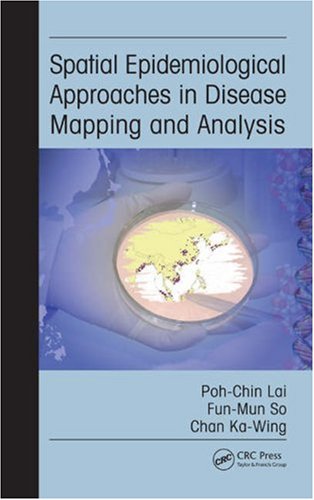Spatial Epidemiological Approaches in Disease Mapping and Analysis 1st Edition by Poh Chin Lai, Fun Mun So, Ka Wing Chan 0367577496 9780367577490
$50.00 Original price was: $50.00.$35.00Current price is: $35.00.
Spatial Epidemiological Approaches in Disease Mapping and Analysis 1st Edition by Poh Chin Lai, Fun Mun So, Ka Wing Chan – Ebook PDF Instant Download/Delivery: 0367577496, 9780367577490
Full download Spatial Epidemiological Approaches in Disease Mapping and Analysis 1st Edition after payment

Product details:
ISBN 10: 0367577496
ISBN 13: 9780367577490
Author: Poh-Chin Lai, Fun-Mun So, Ka-Wing Chan
Containing method descriptions and step-by-step procedures, the Spatial Epidemiological Approaches in Disease Mapping and Analysis equips readers with skills to prepare health-related data in the proper format, process these data using relevant functions and software, and display the results as mapped or statistical summaries.
Spatial Epidemiological Approaches in Disease Mapping and Analysis 1st Table of contents:
1 GIS Concepts and Operations
1.1 What Is a GIS?
1.2 What a GIS Is Not
1.3 GIS Components and Functionalities
1.3.1 Data
1.3.2 Equipment
1.3.3 Methods
1.3.4 People
1.3.5 Organization
1.4 Basic GIS Operations
1.5 Summary
References
2 GIS and Geographic Data
2.1 Characteristics of Geographic Data
2.1.1 Topological Relations
2.2 GIS Models: Raster versus Vector
2.2.1 Raster
2.2.2 Vector
2.2.3 Attribute
2.3 Data for Spatial Epidemiological Studies
2.4 Georeferencing Locational Information
2.4.1 Geocoding Problems
2.4.2 Choosing the Right Address
2.5 Aggregating Geographic Data
2.5.1 Units of Aggregation
2.5.2 Data Aggregation Concerns
2.6 Summary
References
3 Spatial Analysis Software and Methods
3.1 Introduction
3.2 Software
3.2.1 CrimeStat
3.2.2 GeoDa
3.2.3 HealthMapper
3.2.4 Summary
3.3 Data Sets
3.4 Spatial Analysis
3.4.1 Age–Sex Standardization
3.4.2 Disease Mapping
3.4.3 Spatial Autocorrelation
3.4.4 Geostatistical Analysis
3.5 Summary
References
4 Point Pattern Methods of Disease Analysis
4.1 Examining Point Patterns
4.2 Elementary Analysis of Disease Data by Visualization
Step 1: Examining the SARS Data File
Step 2: Reading Point Data into GeoDa
Step 3: Adding a Base Map in GeoDa
Step 4: Linking Interactively the Map and Its Disease Attribute Table
Step 5: Displaying Disease Locations as Proportional Point Symbols
4.3 Cluster Analysis: Nearest Neighbor Distance
Step 1: Setting Up a Workspace in CrimeStat
Step 2: Specifying Input Data
Step 3: Specifying Measurement Parameters and Computing NNI
Step 4: Examining Local Patterns
4.4 Contextual Analysis
Step 1: Setting Up a Workspace in CrimeStat
Step 2: Specifying Input Data
Step 3: Specifying Measurement Parameters and Computing SDE
Step 4: Displaying SDE Using the HealthMapper
4.5 Constraints and Limitations
4.6 Summary
References
5 Areal Methods of Disease Analysis
5.1 Areal Pattern Analysis
5.2 Areal Mapping
5.2.1 Disease Rates
5.2.2 Rate Smoothing Techniques
5.2.2.1 The Empirical Bayes Smoothing Method
5.2.2.2 The Spatial Empirical Bayes Smoothing Method
5.3 Constraints and Limitations of Choropleth Mapping
5.3.1 Data Classification in Choropleth Maps
5.3.2 Modifiable Areal Unit and Area Dependence Problems
5.4 Spatial Dependence
5.4.1 Measures of Spatial Autocorrelation
5.5 Spatial Autocorrelation Analysis with GeoDa
Step 1: Examining the Dengue Data File
Step 2: Constructing Spatial Weights
Step 3: Examining Characteristics of Spatial Weights
Step 4: Constructing Spatially Lagged Variables
Step 5: Visualizing the Moran Scatterplot
Step 6: Assessing Statistical Significance of Moran’s I
Step 7: Compiling Univariate LISA
5.6 Summary
References
6 Interpolation and Associative Analysis
6.1 Spatial Sampling and Interpolation
6.1.1 Kernel Density Estimation
6.1.1.1 Kernel Density Estimation of Asthma Occurrences in Hong Kong
Step 1: Setting Up a Workspace in CrimeStat
Step 2: Specifying Input Data
Step 3: Specifying Grid Reference
Step 4: Kernel Density Estimation
Step 5: Displaying Results of Kernel Density Estimation
6.1.1.2 Constraints and Limitations of the Kernel Density Method
6.1.1.2.1 Choice of a Bandwidth
6.1.1.2.2 Choice of a Grid Size
6.1.1.2.3 Census Tract versus Grid Cell Visualization
6.1.2 Spatial Interpolation Methods
6.1.2.1 IDW and Its Constraints
6.1.2.2 Spline and Its Constraints
6.1.2.3 Kriging (Ordinary or Universal) and Its Constraints
6.1.2.4 Spatial Interpolation of Air Pollution Index (API) of Hong Kong
6.2 Associate Analysis
6.2.1 Application of Interpolated Surface in Associate Analysis: The Risk of Asthma Relative to API of Hong Kong
6.2.2 Application of Socioeconomic Data in Associate Analysis: Risk of Asthma Relative to Monthly Household Income of the Population of Hong Kong
6.3 Summary
References
7 Initiating a GIS Project in Spatial Epidemiology
7.1 Introduction
7.2 Setting Up a GIS Infrastructure
7.3 Conceptualizing a GIS Project
7.3.1 Determining the Focus of a GIS Development
7.3.2 Conceptualizing a GIS Application
Stage 1: Objectives and criteria involve laying down key epidemiological concerns of a GIS application.
Stage 2: Data assembly is about finding suitable data to support the hypothesis testing established in Stage 1 above.
Stage 3: Processing encompasses working out all procedures necessary to convert, align, and touch up data, including simple visualization and data exploration techniques.
Stage 4: Analysis involves charting out and executing spatial queries and analytical sequences.
Stage 5: Presentation includes report writing and map presentation, as illustrated in Figure 3.5 of Chapter 3.
7.4 Signs of an Unfeasible Project
7.5 Summary
References
8 Current GIS Research in Health Care and Disease Analyses
8.1 Geography of Health
8.1.1 Health Outcomes and Epidemiological Studies
8.1.2 Health Care Delivery Applications
8.1.3 Health Care Commissioning and Needs Assessment
8.2 Contagious versus Noncontagious Disease Analyses
8.3 Short-Term versus Long-Term Surveillance and Disease Tracking
8.4 Summary
People also search for Spatial Epidemiological Approaches in Disease Mapping and Analysis 1st:
disease mapping
r epidemiology handbook
gis epidemiology
geospatial epidemiologist
Tags:
Poh Chin Lai,Fun Mun So,Ka Wing Cha,Spatial,Epidemiological



